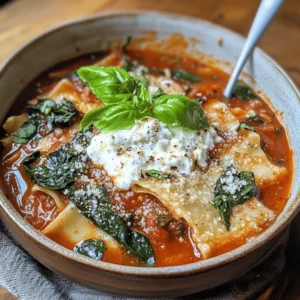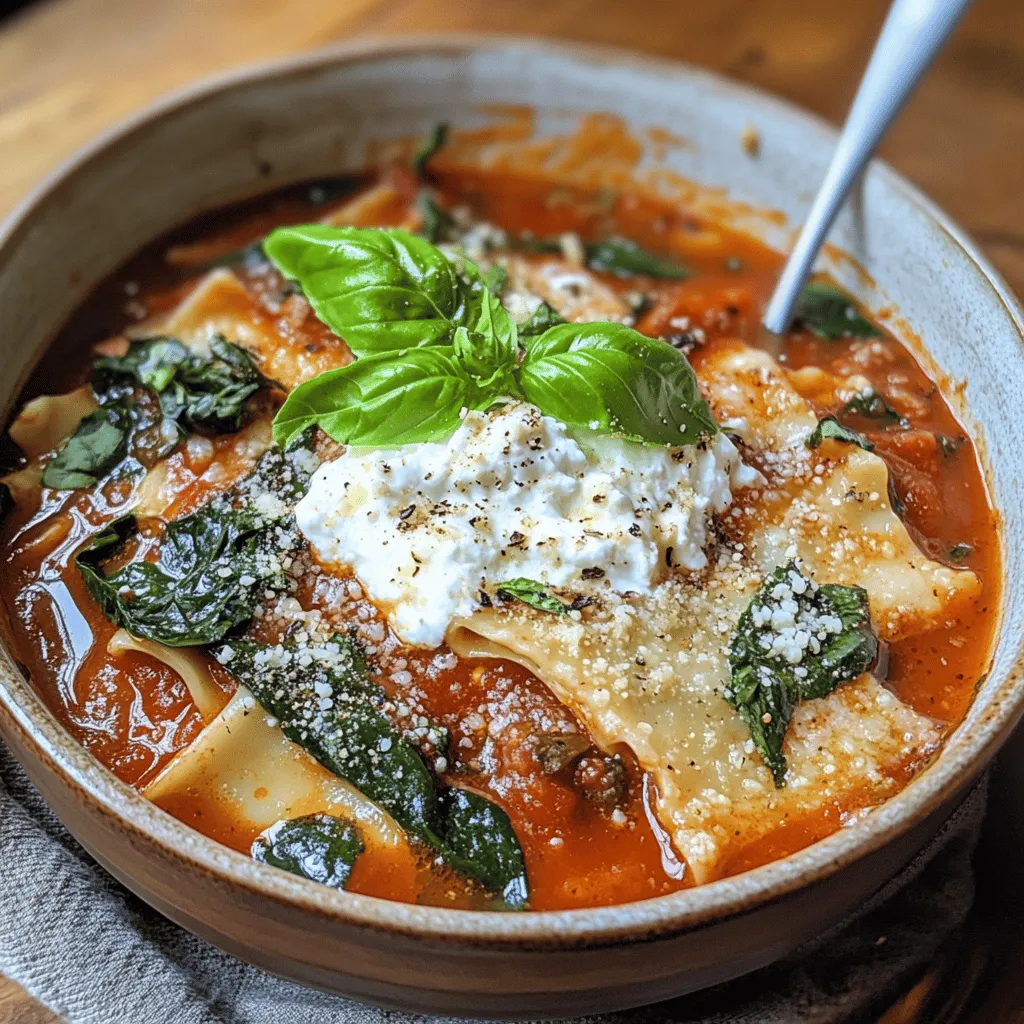Introduction
Lasagna has long been hailed as one of the quintessential comfort foods, cherished for its layers of rich flavors, gooey cheeses, and hearty ingredients. This beloved Italian dish, traditionally baked in a casserole dish and served in thick slices, evokes warmth and satisfaction with every bite. However, as culinary creativity flourishes, new interpretations of classic recipes are emerging, and one such delightful innovation is lasagna soup.
This lasagna soup offers a creative twist that captures the essence of the original dish while presenting it in a new, convenient form. Imagine a bubbling pot of flavorful broth filled with tender pasta, savory meat, and melty cheese, all served in a comforting bowl. This dish is not only heartwarming but also easy to prepare, making it a fantastic weeknight dinner option.
The appeal of lasagna soup lies in its comforting nature, reminiscent of the traditional lasagna, but with the added benefit of being quicker and simpler to cook. It combines all the essential flavors of lasagna into a single pot, reducing both prep time and cleanup. Additionally, this recipe is versatile enough to cater to various dietary preferences. Whether you prefer a vegetarian version, want to adjust the level of spice, or are looking for gluten-free options, the lasagna soup can be easily adapted to meet your needs.
So, roll up your sleeves and get ready to dive into this delicious, hearty soup that’s sure to become a favorite in your household!
Understanding the Ingredients
To make the BEST lasagna soup, it’s essential to focus on high-quality ingredients. Each component plays a significant role in contributing to the overall flavor and texture of the dish.
Key Ingredients Overview
1. Italian Sausage or Ground Beef: The foundation of the soup’s flavor begins with the meat. Using high-quality Italian sausage will impart a robust and savory taste, while ground beef offers a classic profile. If you are looking for a lighter option, ground turkey or chicken can also work well.
2. Aromatics: Onions and garlic are crucial in enhancing the flavor of any soup. Sautéing these aromatics not only releases their natural sweetness but also builds a flavorful base for the entire dish.
3. Crushed Tomatoes and Broth: These two ingredients are pivotal in creating the soup’s rich and hearty consistency. Crushed tomatoes provide acidity and depth, while broth (chicken, beef, or vegetable) adds warmth and body to the soup.
4. Spices: A blend of Italian seasoning, salt, and pepper brings out the flavors of all the ingredients. Italian seasoning, often a mix of dried herbs like basil, oregano, and thyme, is particularly important for replicating the classic Italian taste of lasagna.
5. Fresh Ingredients: To finish off the soup, adding fresh spinach not only boosts the nutritional value but also adds a bright color. The final touch comes from a mixture of ricotta, mozzarella, and Parmesan cheese, which contributes creaminess and richness, enhancing the comforting experience of the soup.
Importance of Ingredient Quality
Choosing high-quality ingredients can elevate your lasagna soup from good to exceptional. Fresh herbs and spices will have more vibrant flavors, and using artisanal cheeses can significantly enhance the creaminess and taste of the finished dish. Don’t skimp on the meat either; select a sausage with a good fat content for the juiciest results.
Step-by-Step Instructions for the Perfect Lasagna Soup
Now that we understand the importance of our ingredients, let’s dive into the step-by-step process of preparing this remarkable lasagna soup. Follow these detailed instructions to ensure a flawless execution:
1. Sautéing the Meat
Start by heating a large pot or Dutch oven over medium heat. Add a drizzle of olive oil, then carefully add the Italian sausage or ground beef. Use a wooden spoon to break the meat apart as it cooks. Allow it to brown evenly, which should take about 5-7 minutes. The browning process is crucial as it develops deep flavors through the Maillard reaction, which adds complexity to your soup.
2. Cooking the Aromatics
Once the meat is browned and fully cooked, add the chopped onion and minced garlic to the pot. Sauté these ingredients for about 3-4 minutes until the onions become translucent and fragrant. This step is vital for maximizing flavor; the sweet onion and aromatic garlic will infuse the broth, creating a hearty foundation for your soup.
3. Combining the Tomatoes and Broth
Next, it’s time to incorporate the crushed tomatoes into the pot. Stir well to combine with the meat and aromatics, allowing the mixture to simmer for 2-3 minutes. This helps meld the flavors together. After that, pour in your choice of broth (chicken, beef, or vegetable) and stir to combine. Bring the mixture to a gentle simmer and add the Italian seasoning, salt, and pepper. Taste and adjust the seasoning to your preference.
4. Cooking the Noodles
While the soup is simmering, you can start preparing the lasagna noodles. You have a couple of options here. You can break the uncooked lasagna noodles into smaller pieces and add them directly to the soup, or you can cook them separately according to package directions. If cooking separately, be sure to undercook them slightly, as they will continue to absorb the soup’s liquid while they sit. If you choose to break them and add them directly to the soup, allow the noodles to cook in the simmering broth for about 10-12 minutes, or until they reach your desired level of doneness.
5. Incorporating Spinach
As the noodles begin to soften, add a generous handful of fresh spinach to the pot. Stir it in and allow it to wilt for about 2 minutes. This not only enhances the nutritional profile of your soup but also adds a beautiful pop of color.
6. Preparing the Cheese Mixture
While the soup is simmering, prepare the cheese mixture. In a separate bowl, combine ricotta cheese, shredded mozzarella, and grated Parmesan cheese. Mix well until the cheeses are fully incorporated. This cheesy goodness will add a rich creaminess to your soup when served.
7. Serving Suggestions
To serve your lasagna soup, ladle it into bowls and top each serving with a generous dollop of the cheese mixture. You can also sprinkle additional shredded mozzarella and freshly chopped basil or parsley for garnish. Serve with crusty bread or garlic bread for a complete meal that will leave everyone satisfied.
By following these steps, you will create a comforting lasagna soup that embodies all the flavors of the traditional dish while offering a modern and convenient twist. This recipe is not just a meal; it’s an experience—a delicious journey that brings the warmth of home cooking into your kitchen.

Exploring Flavor Profiles
Lasagna soup is a culinary masterpiece that beautifully marries the classic flavors of traditional lasagna with the comforting essence of soup. The flavor combinations in this dish are thoughtfully crafted, creating a harmonious blend that tantalizes the taste buds.
At the heart of the flavor profile is the sweetness of ripe tomatoes, which serve as the base of the soup. This natural sweetness is perfectly balanced by the savory notes of Italian sausage. The sausage not only adds depth to the dish but also infuses it with a delightful richness that complements the tomatoes beautifully. When these two primary ingredients meld together, they create a comforting foundation that is both hearty and satisfying.
Adding to the complexity of flavors, the creamy texture of ricotta and mozzarella cheese provides a luscious mouthfeel that contrasts with the sharpness of freshly grated Parmesan. The ricotta cheese contributes a smooth, mild creaminess, while the mozzarella melts into the soup, creating gooey pockets of cheese that enhance every spoonful. The Parmesan, with its nutty and slightly tangy flavor, adds an additional dimension that rounds out the overall taste experience.
To finish off this delicious bowl of comfort, fresh basil is introduced as a bright, aromatic element. Its herbaceous notes not only elevate the visual appeal of the dish but also intensify the flavor profile. The freshness of basil complements the rich and savory ingredients, providing a perfect balance that invites you to savor every bite.
Nutritional Benefits of Lasagna Soup
As hearty as it is delicious, lasagna soup also offers a range of nutritional benefits, making it a wholesome choice for any meal. The ingredients come together to create a dish that is both comforting and nutritious, appealing to those looking for a satisfying meal without compromising on health.
Each serving of lasagna soup is packed with protein, primarily from the sausage, which is essential for muscle repair and growth. If you opt for turkey sausage or a plant-based alternative, you can still enjoy a protein-rich meal that supports a balanced diet. Additionally, the inclusion of spinach provides a wealth of vitamins and minerals, including vitamin K, vitamin A, and iron, which are crucial for maintaining overall health.
The cheeses in lasagna soup, particularly ricotta and mozzarella, contribute calcium and protein as well. Calcium is vital for bone health, while the proteins help with satiety, keeping you fuller for longer. When compared to traditional lasagna, which often contains layers of pasta and additional cheese, lasagna soup generally has fewer calories and carbohydrates, particularly when you customize it with gluten-free pasta or by reducing some of the cheese.
Overall, lasagna soup emerges as a fantastic option for those seeking comfort food that is also nourishing. By carefully selecting your ingredients, you can create a dish that aligns with your dietary preferences while still delivering on flavor.
Variations and Customizations
One of the greatest joys of cooking is the ability to adapt recipes to suit individual tastes and dietary needs. Lasagna soup is no exception, allowing for various protein substitutions and ingredient modifications that can enhance the dish while accommodating different preferences.
For those looking to lighten their meal, turkey sausage is an excellent alternative to traditional pork sausage, providing a similar flavor profile with less fat. If you’re interested in exploring plant-based options, consider using lentils, tempeh, or a meat substitute like Beyond Meat to achieve a hearty, satisfying soup without meat.
If dietary restrictions necessitate gluten-free options, there are numerous gluten-free pasta alternatives available. Products made from rice, corn, or chickpeas can be used to create a delicious base for your lasagna soup without sacrificing texture or taste.
Incorporating additional vegetables is another fantastic way to boost the nutritional profile of your lasagna soup. Adding diced zucchini, bell peppers, or mushrooms not only enhances the flavor but also increases the fiber content, making the dish even more filling. Simply sauté these vegetables alongside the sausage or add them directly to the broth to allow their flavors to meld into the soup.
For those following a vegan diet, the recipe can be easily modified by substituting dairy products with plant-based alternatives. Use cashew cream or silken tofu blended for a creamy texture in place of ricotta, and opt for a dairy-free mozzarella to maintain the gooey, cheesy goodness. Replace the sausage with a flavorful plant-based option or sautéed mushrooms to retain the hearty essence of the dish.
Storing and Reheating Lasagna Soup
One of the many advantages of lasagna soup is its ability to store and reheat beautifully, making it an ideal choice for meal prep or leftovers. To ensure maximum freshness, follow these best practices for storing your soup.
After cooking, allow the lasagna soup to cool completely before transferring it to an airtight container. This helps prevent moisture accumulation, which can lead to sogginess. The soup can be stored in the refrigerator for up to three days, allowing you to enjoy this comforting dish throughout the week.
When it comes to reheating, there are a few tips to keep the flavors and textures intact. Gently heat the soup on the stovetop over medium-low heat, stirring occasionally to prevent sticking. If the soup has thickened too much upon cooling, simply add a splash of broth or water to achieve your desired consistency. Alternatively, you can microwave individual portions in a microwave-safe container, heating in short intervals and stirring in between to ensure even warming.
For longer-term storage, lasagna soup can be frozen for up to three months. To freeze, pour the cooled soup into freezer-safe bags or containers, leaving some space for expansion. When you’re ready to enjoy it again, thaw the soup overnight in the refrigerator before reheating on the stovetop or in the microwave.
Conclusion
In summary, the best lasagna soup recipe offers a delightful combination of comforting flavors and nutritional benefits that make it an appealing meal choice any day of the week. Its versatility allows for numerous adaptations, whether you prefer to stick to the classic recipe or customize it to cater to dietary needs.
From the rich sweetness of tomatoes paired with savory sausage to the creamy cheeses and fresh basil, each component contributes to the heartiness of the dish. The nutritional value of lasagna soup makes it a guilt-free indulgence, providing protein, vitamins, and minerals essential for a balanced diet.
Whether you’re serving it on a chilly evening or enjoying it as part of your meal prep, lasagna soup is an easy-to-make dish that brings comfort to your table. Embrace the warmth and satisfaction that comes with each spoonful, and enjoy this hearty soup as a staple in your culinary repertoire.



